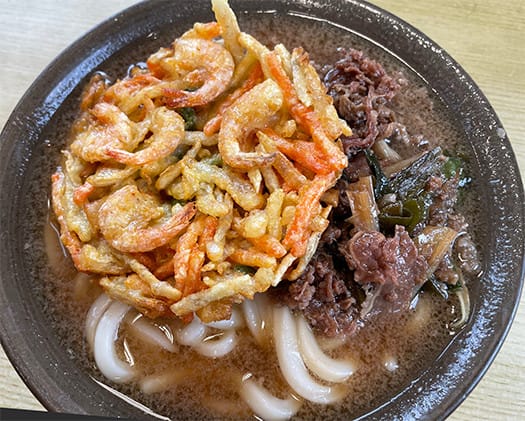
わたしくらいの年代だと、博多はとんこつスープのラーメンが有名で、札幌の「味噌」ラーメンと対を張っているというイメージが多い。日本人は3食ともごはんを主食にするよりも1食程度は「麺類」を食べたくなるのが常態。そういった麺類として外食では札幌では圧倒的にラーメン店が多いし、対比的に博多はほぼとんこつが街を覆っているようなイメージを持っている。なのですが、今回博多の街を歩いていると、どうも勝手が違う。
そうなんです、やたらめったら「うどん」の地元チェーン店が繁殖している。
たしか「うどん」県を自称している香川県で地元の人から「実はね、博多もうどんが多いんですよ。いまや負けそう(笑)」という話は聞いていたけれど、目で見て舌で味わってみて、納得させられた。2店食べ歩いてみたけれど、こちらでは基本、太いうどんで写真のように牛肉の煮込み風のトッピングが主流。さっぽろラーメンでいえば「もやし」に相当するようなものが牛肉のようなのですね。
郷に入らば郷に従って、ほぼ定番メニューに従っていると、写真のような表情の料理がやってくる。
最近はあぶらっこい料理は避けているのですが、「これが一番の売れ筋」という言葉に従って、ちょっと冒険してみた次第。
こういう風な食べ始めなのですが、けっこう食べてもなかなか「底が見えない」。
そうしていると店員さんがヤカンを持ってきて、どうもつゆを継ぎ足すのがお約束のようです。食べても食べてもうどんが減らないのは、どうもつゆを麺が「吸い取っている」かのようなのですね。面白がって、地元の人の作法を真似して継ぎ足してみる。
牛肉煮込みの甘みはすこし減ってきて、出汁の味が多くなってくるので、どうも1食で2食分というか、違ううどんメニューを2つ食べたような後味が残る。
さっぽろラーメンで味噌ラーメンを食べると終始一貫、味噌味一択の味わいだけれど、どうも博多のうどんは微妙に変化して行く食べものと対しているかのようなのです。
まぁこういう体験感はこちらの「牧のうどん」の様子で、もう1軒寄ってみた「資(すけ)さんうどん」ではもうちょっとシンプルな味わいだった。
その他、たくさんの「こだわり系」うどん店が各所に猖獗を極めていて、博多人の胃袋を直撃している様子がよくわかる。こういった食べものの地域個性というのは旅人には楽しい。だんだん博多に染まっていく単純明快さ。単細胞に楽しんでおりました。うまかった。
English version⬇
Hakata, Kyushu is an "Udon culture" area.
Hakata's "Udon" culture was alarmed by the people of Sanuki Kagawa. Enjoy the local texture comparable to that of tonkotsu ramen. ...
Many people my age have the impression that Hakata is famous for its tonkotsu (pork bone) soup ramen, which is paired with Sapporo's "miso" ramen. Japanese people usually want to eat "noodles" for at least one meal rather than having rice as their staple food for all three meals. In contrast, Hakata has the image of tonkotsu (pork bone broth) covering the city almost exclusively. However, when I walked around the streets of Hakata this time, I found something different.
Yes, there are a lot of local udon noodle chain restaurants.
I remember hearing from a local in Kagawa Prefecture, which calls itself an "udon" prefecture, "Actually, there are a lot of udon restaurants in Hakata, too. I tried two restaurants, but the basic type of udon here is thick udon noodles topped with stewed beef, as shown in the photo. In Sapporo ramen, the equivalent of "bean sprouts" is beef.
If you follow the hometown, follow the hometown, and follow almost the standard menu, the dish with the look shown in the photo will come to you.
Recently, I have been avoiding the more abusive dishes, but following the words "this is the best seller," I decided to venture out a bit.
I started eating like this, but I couldn't "see the bottom" even after eating quite a bit.
The waiter brought a kettle and added more broth to the udon. The reason why the udon noodles never seem to get smaller, no matter how much you eat, is that the noodles seem to be "soaking up" the sauce. Amused, I imitate the locals' manners and try to add more.
The sweetness of the stewed beef flavor is reduced and the broth taste increases, leaving an aftertaste as if I had two meals in one, or two different udon dishes.
When you eat miso ramen at Sapporo Ramen, the miso flavor is the only one you can choose, but Hakata udon is like a food that changes slightly.
Well, this kind of experience was the case at Maki's Udon, while the other place I stopped by, Suke-san Udon, had a simpler taste.
In addition, there are many other "stick-to-itiveness" type udon stores in various locations, and it is easy to see how they are hitting the stomachs of Hakata residents. This kind of regional individuality in food is fun for travelers. It is simple and clear that you are gradually becoming more and more familiar with Hakata. I was enjoying myself in a single-minded way. It was delicious.



















